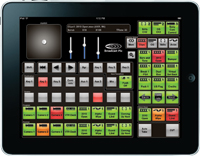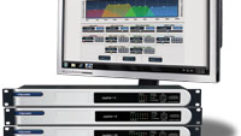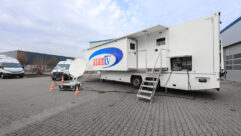

Broadcast Pix iPixPanel Review
Jun 21, 2010 12:00 PM,
By Jeff Sauer
An Apple iPad app for wireless live production switching.
Broadcast Pix iPixPanel
Broadcast Pix sells video production switchers that, on the surface anyway, can look similar to traditional switchers. Specifically, many Broadcast Pix configurations use standard-layout 1M/E or 2M/E control panels. But Broadcast Pix has never tried to be like every other switcher maker, and the new iPixPanel is a great example of the benefits of the company’s unique approach.
Instead of typical “black box” switchers, Broadcast Pix switchers leverage the horsepower of general-purpose Windows computers to handle the video processing, which has given the company’s products several unique features. The iPixPanel is the latest such product. The iPixPanel provides a new wireless control panel interface that can work in tandem with a traditional 1M/E or 2M/E panel or even as the main control interface for live production.
The iPixPanel is a software application ($199) that runs on an Apple iPad tablet computer and essentially duplicates the Broadcast Pix SoftPanel virtual control panel that displays on the Windows monitor. Instead of SoftPanel‘s tethered computer mouse to depress virtual onscreen buttons, the iPixPanel leverages the built-in wireless capabilities of a Broadcast Pix Slate or Granite switcher systems to offer a cable-free, touchscreen control panel.
All right, so why would any serious switching pro want to use a touchscreen interface to run a live video production? After all, the whole idea of using a traditional 1M/E or 2M/E panel is so experienced users can operate by feel and keep their eyes on the action where they ought to be. Skating one’s fingers around on a touchscreen and hoping you’ve got the right source doesn’t sound all that practical in a fast-paced, live switching environment. But, of course, that’s clearly not what Broadcast Pix had in mind with the iPixPanel.
Offload the upload
Last fall, Broadcast Pix released the iPixPad application for the Apple iPhone. Admittedly, the tiny iPhone screen seems even less practical for live switching than the touchscreen of the iPad. Despite what might seem like little more than a clever gimmick, Broadcast Pix claims that the iPixPad on the iPhone has been surprising well-received and has already been used to facilitate the live production of major red-carpet events. Its value is in offloading a specific set of assistance functions to a secondary device—one where function matters more than size.
On an iPhone, the iPixPad replicates the PixPad section of the switcher control panel, which cues up stored stills, logos, other CGs, and video clips. Duplicating those content store and cue functions on a separate device, no matter how small it is, allows a production assistant to do the loading and cueing of content for a production director, thereby allowing the director’s eyes to stay on the action. Since the two devices work in tandem, no element of production gets taken away from the main panel. Rather than having four hands crowded around one panel, the assistant can give the director space while still doing an important job.
The iPixPanel on an iPad tablet does much the same, except in a larger and far more capable interface. With the larger iPad workspace, a production assistant can better identify the electronically labeled PixButtons and work more effectively finding, loading, and cueing content and transitions into the PixPanel. But the iPixPanel also has the real estate to run the entire SoftPanel.
Beyond just loading clips, that added functionality affords the iPixPanel remote control of external devices. It can trigger secondary video source devices, pan and frame remote-controlled cameras using a virtual joystick function, set up color keys, and trigger clip previews in one of the sub-sample frames on the main Windows monitor.
For less than $200, plus the cost of an iPad tablet, the iPixPanel offers an inexpensive value-add tool that can play a major role in a large-scale production. Of course, appealing to cost-conscious organizations has also been one of Broadcast Pix’s calling cards.
Broadcast Pix iPixPanel Review
Jun 21, 2010 12:00 PM,
By Jeff Sauer
An Apple iPad app for wireless live production switching.
Multitasking live production
Not all live productions are high-budget, nor does every production director have an assistant. Broadcast Pix has sold plenty of systems to organizations that do use a computer keyboard and mouse rather than a full-blown 2M/E panel, and to users for whom it’s important to have everything in front of them in one place so they can run a production single-handed. While even Broadcast Pix doesn’t envision too many productions running exclusively off an iPixPanel, it’s clear that some could.
Related Links

AKG Wireless iPhone and iPod touch App
AKG has effectively streamlined the workflow for wireless microphone monitoring and configuration by linking Harman’s HiQnet protocol to the iPhone and iPod touch app via Wi-Fi network…

At InfoComm 2010 in Las Vegas, Xantech will demonstrate its Apple iPad-enabled MX audio/video and home-automation controller, which the company introduced earlier this year and will now be shipping this quarter…

Crestron’s new Mobile Pro G iPad app is a seamless merging of iPad resolution and Crestron innovation. …
Imagine a smaller-budget organization—such as a local access cable TV station or a mid-sized house of worship—with one AV guy, probably a volunteer, running an entire production solo much of the time. Those types of productions tend to have fewer fast back-and-forth cuts, so the tactile facility of a physical control panel is less critical. On the other hand, that one AV guy may also be the lighting guy, the sound guy, and the production assistant all rolled into one.
Now imagine that one AV guy setting up the lighting for a shoot. Instead of going back and forth from the lights to the panel time and again, he’s carrying an iPad that can control his entire system. He can adjust the lighting and the cameras from the same stop, as well as trigger a computer-based presentation or do a sound check, all from one location in the studio or hall. What’s more, if he’s a camera operator too, he could even run the switching from his camera location. Ideal? Heck, no. Ideal would be a staff of five. But perhaps it is reality.
I’ve been around wireless technology long enough to remember connectivity issues, and I always worry about latency—particularly when video is involved. But with the iPixPanel, I found that latency was not an issue. Since there is no actual video traveling wirelessly, the amount of data—just small system commands—moving between the iPad and the system is quite insignificant from a bandwidth perspective. Naturally, the touchscreen controls don’t offer the same response as a fader bar, and the joystick will take some getting used to, but takes are fluid.
Best of all, there is very little required in terms of configuration in order to use the iPixPanel. The wireless capability is a function of the Apple iPad and the Windows operating system that runs behind all Broadcast Pix switchers. Therefore, Slate and Granite systems, which already include the SoftPanel, natively include the functionality to run the iPixPanel.
Gadget freaks are probably going to love the iPixPanel, but it’s an easy and inexpensive add-on for a variety of live production switching systems. Large-scale productions will use it to offload functions to one or more assistants, and one-man production studios will value the flexibility it affords around the studio. At less than $200, it’s an easy, if not a relatively painless, add-on to the cost of a switcher.
Product Summary
- Company: Broadcast Pix
www.broadcastpix.com - Product: iPixPanel
- Pros: Flexibility and freedom of wireless for offloading functions from the main control panel, remote control of external devices, low price for the added facility.
- Cons: Touchscreen interface offers no familiar feel.
- Applications: Live production.
- Price: $199 (plus the cost of an Apple iPad)
Specifications
- Required hardware: Apple iPad tablet computer; works with any Broadcast Pix Slate or Granite switcher
- PixPanel functions: Device select, clip and graphics select, transition select, direct keys, take to air
- Joystick functions: Key positioning, camera positioning
- Other functions: Clip motion control, preview control, fill control, program/source control, shift view source, take to air
- Wireless technology: 802.11n (built-into Apple iPad)









